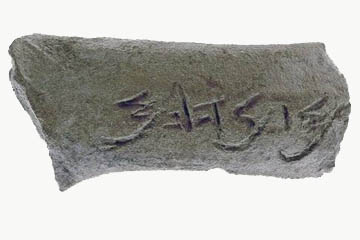Menachem's Jar
There is nothing more frustrating than a rescue dig, particularly if you find something that is interesting - important even - but not important enough to stop the developers moving in to bury whatever it is that you have found beneath tons of concrete (or worse still, to cart it all off to the dump in big trucks). Something of the sort has happened on the Mount of Olives, where a girls' school is being built.
It must have surprised no one when the builders uncovered ancient remains. I always chuckle when I walk down the ancient pathway from Bethany to Gethsemane; on the left there is a sign pointing to a gateway and claiming that within the gate lie the tombs of the prophets Haggai and Zechariah. I visited the tomb some years ago and found it to be a typical 1st century AD Jewish tomb - a circular tunnel from the sides of which a series of kokhim open off. It is no more the tomb of the two prophets than the Garden Tomb is the tomb of Christ.
I got into conversation with the friendly young Arab who had taken my admission money and asked him how his family had discovered the tombs. Apparently they had suffered considerable loss in 1948 when the State of Israel was founded and one day his father, digging in the garden, had found the entrance to the tomb. Out of curiosity he had followed it down into the ground and was astonished when the tunnel was revealed. However, feeling that the Jews had been responsible for the family's losses, he decided to use the Jews to make good the family finances, so had picked the first two Jewish prophets' names he came across, then put up the sign.
"Do you make much money?" I enquired.
The young chap moved his hand from side to side to indicate that the income was ok but not marvellous, but his eyes gleamed and twinkled and I gathered that the money from the sale of tickets was a useful adjunct to the family budget - and I had noticed one of the kokhim choked with paper notes, presumably prayers from the gullible faithful.
Quite correctly, the builders of the girls' school called in the Israeli' Antiquities Authority to investigate the remains and a team set to work under Ron Beeri. They swept and scraped, mapped and photographed, and no announcement has been made about what they found, so I presume that a) they don't know, and b) whatever it is, it isn't important.

|
| The inscribed jar handle. The name was scratched in the clay before the jar was fired. |
However the team did make one find - a jar handle from the Iron Age, which Ron Beeri dates to around 900 BC. Such handles are not altogether uncommon, but when the day's digging was over the team repaired to the nearby shed and started to wash the pottery, a routine task that no one enjoys but which has to be done - and in this case, which struck the gold that is the reason for the washing. On the handle there was a name, "Menachem", and what looked like the letter 'L' in front of it.
Beeri claims that the 'L', which means "to" in Hebrew, indicates that the jar and/or its contents was a gift. I rather doubt that: many such inscriptions have been found - usually in the lump of clay which sealed a jar or amphora - and in all the ones of which I have heard the 'L' has been interpreted as short-hand for "belonging to ..."
Many of these inscribed jars bear the names of Biblical kings of either Judah or Israel and "Menachem" was the name of one of Israel's kings, but it is doubtful whether this jar was his property. Menachem is by no means an unusual name in Jewish circles, even today, and it could well be that this jar was the property of Menachem the farmer or Menachem the potter or some other menial task. After all, why would Menachem of Israel, who was no friend to Judah, come down to Judah or sent some of his belongings there.
On the other hand we know very little about his reign. The Biblical book of Kings dismisses him as one who "did evil" and simply records that he assassinated his predecessor on the throne and was guilty of committing an atrocity at Tiphsah because the inhabitants were slow about recognising his authority. It also mentions that he was attacked by the Assyrians and made a hasty peace with them that cost him 10,000 talents of silver - a talent is 75lbs, so that was quite a lump of silver!
The Bible records that Menahem taxed the people of Israel heavily to pay his debt to the Assyrian king and it is not beyond the realms of possibility that he may have sent some of the goods from his storerooms down to Judah for sale there in order to raise more money.
Unfortunately the handle is all that we have of the jar or amphora, so we can't tell what was in it - wine? oil? grain? - nor can we give a more accurate date. Still, as the builders get on with erecting the girls' school, we can give ourselves up to imagining how and why Menachem's jar ended up on the Mount of Olives. Was it a peace offering to try and obtain the help of Judah in resisting the Assyrians? Was it, as I suggest above, an attempt to raise money? Or was it some dishonest steward who stuck the amphora under his robe and strolled out of the store room with it, then sold it down in Judah where no one would question his right to the jar and its valuable contents?
© Kendall K. Down 2009





